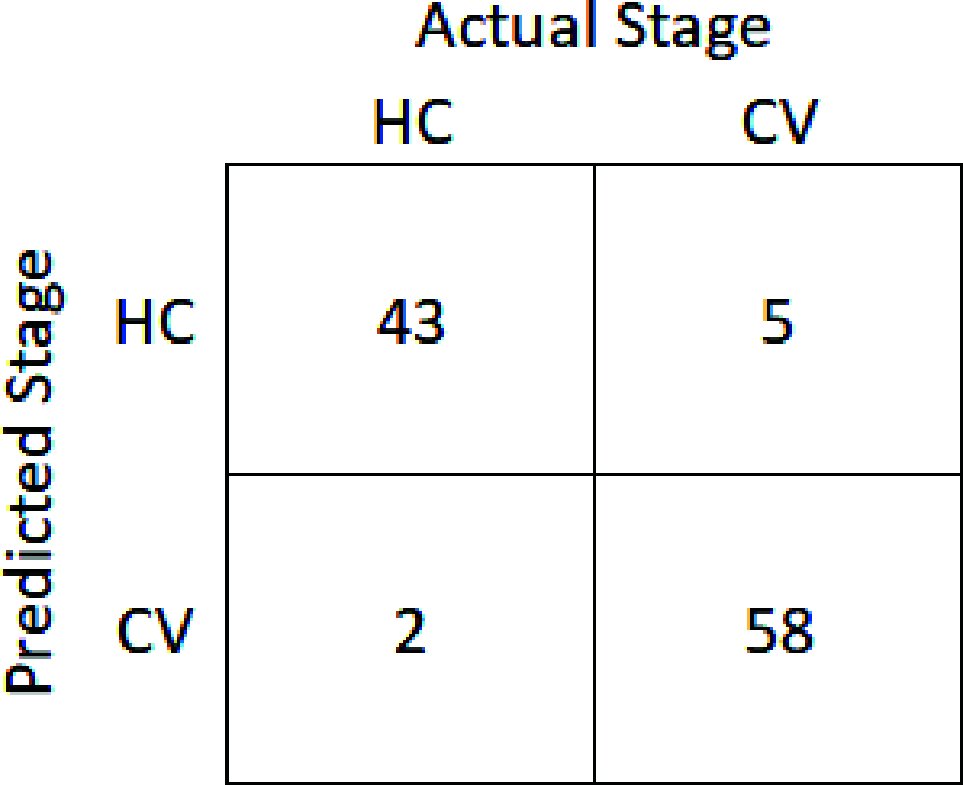Voice Features of Sustained Phoneme as COVID-19 Biomarker
- PMID: 36304844
- PMCID: PMC9592047
- DOI: 10.1109/JTEHM.2022.3208057
Voice Features of Sustained Phoneme as COVID-19 Biomarker
Abstract
Background: The COVID-19 pandemic has resulted in enormous costs to our society. Besides finding medicines to treat those infected by the virus, it is important to find effective and efficient strategies to prevent the spreading of the disease. One key factor to prevent transmission is to identify COVID-19 biomarkers that can be used to develop an efficient, accurate, noninvasive, and self-administered screening procedure. Several COVID-19 variants cause significant respiratory symptoms, and thus a voice signal may be a potential biomarker for COVID-19 infection.
Aim: This study investigated the effectiveness of different phonemes and a range of voice features in differentiating people infected by COVID-19 with respiratory tract symptoms.
Method: This cross-sectional, longitudinal study recorded six phonemes (i.e., /a/, /e/, /i/, /o/, /u/, and /m/) from 40 COVID-19 patients and 48 healthy subjects for 22 days. The signal features were obtained for the recordings, which were statistically analyzed and classified using Support Vector Machine (SVM).
Results: The statistical analysis and SVM classification show that the voice features related to the vocal tract filtering (e.g., MFCC, VTL, and formants) and the stability of the respiratory muscles and lung volume (Intensity-SD) were the most sensitive to voice change due to COVID-19. The result also shows that the features extracted from the vowel /i/ during the first 3 days after admittance to the hospital were the most effective. The SVM classification accuracy with 18 ranked features extracted from /i/ was 93.5% (with F1 score of 94.3%).
Conclusion: A measurable difference exists between the voices of people with COVID-19 and healthy people, and the phoneme /i/ shows the most pronounced difference. This supports the potential for using computerized voice analysis to detect the disease and consider it a biomarker.
Keywords: COVID-19; support vector machine; sustained phoneme; voice features.
Figures




Similar articles
-
Phonemes based detection of parkinson's disease for telehealth applications.Sci Rep. 2022 Jun 11;12(1):9687. doi: 10.1038/s41598-022-13865-z. Sci Rep. 2022. PMID: 35690657 Free PMC article.
-
Machine Learning-based Voice Assessment for the Detection of Positive and Recovered COVID-19 Patients.J Voice. 2024 May;38(3):796.e1-796.e13. doi: 10.1016/j.jvoice.2021.11.004. Epub 2021 Nov 26. J Voice. 2024. PMID: 34965907 Free PMC article.
-
Detecting Effect of Levodopa in Parkinson's Disease Patients Using Sustained Phonemes.IEEE J Transl Eng Health Med. 2021 Mar 17;9:4900409. doi: 10.1109/JTEHM.2021.3066800. eCollection 2021. IEEE J Transl Eng Health Med. 2021. PMID: 33796418 Free PMC article.
-
Universal screening for SARS-CoV-2 infection: a rapid review.Cochrane Database Syst Rev. 2020 Sep 15;9(9):CD013718. doi: 10.1002/14651858.CD013718. Cochrane Database Syst Rev. 2020. PMID: 33502003 Free PMC article.
-
Physical interventions to interrupt or reduce the spread of respiratory viruses.Cochrane Database Syst Rev. 2020 Nov 20;11(11):CD006207. doi: 10.1002/14651858.CD006207.pub5. Cochrane Database Syst Rev. 2020. Update in: Cochrane Database Syst Rev. 2023 Jan 30;1:CD006207. doi: 10.1002/14651858.CD006207.pub6. PMID: 33215698 Free PMC article. Updated.
Cited by
-
Vocal biomarkers correlate with FEV1 variations during methacholine challenge.Clin Transl Allergy. 2025 Apr;15(4):e70055. doi: 10.1002/clt2.70055. Clin Transl Allergy. 2025. PMID: 40155363 Free PMC article.
-
Voice Assessment and Vocal Biomarkers in Heart Failure: A Systematic Review.Circ Heart Fail. 2025 Aug;18(8):e012303. doi: 10.1161/CIRCHEARTFAILURE.124.012303. Epub 2025 Apr 24. Circ Heart Fail. 2025. PMID: 40270235 Free PMC article. Review.
-
Severity Classification Using Dynamic Time Warping-Based Voice Biomarkers for Patients With COVID-19: Feasibility Cross-Sectional Study.JMIR Biomed Eng. 2023 Nov 6;8:e50924. doi: 10.2196/50924. eCollection 2023. JMIR Biomed Eng. 2023. PMID: 37982072 Free PMC article.
References
-
- WHO. WHO Coronavirus (COVID-19) Dashboard. Accessed: Jan. 28, 2022. [Online]. Available: https://covid19.who.int/
Publication types
MeSH terms
Substances
Supplementary concepts
LinkOut - more resources
Full Text Sources
Medical

